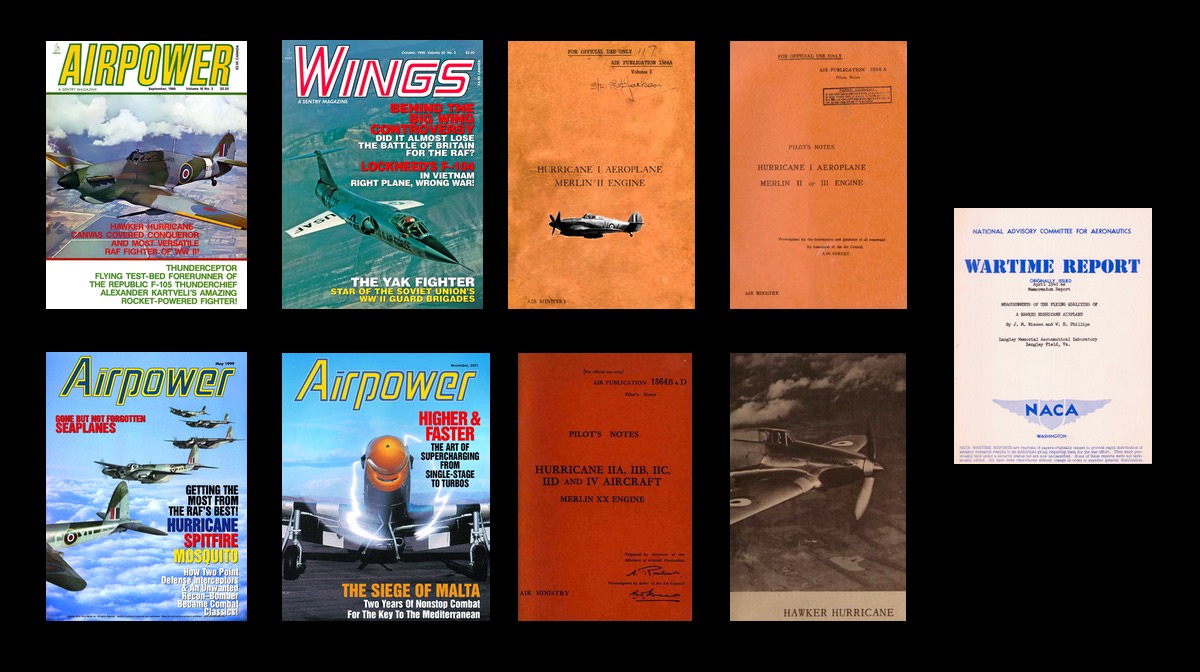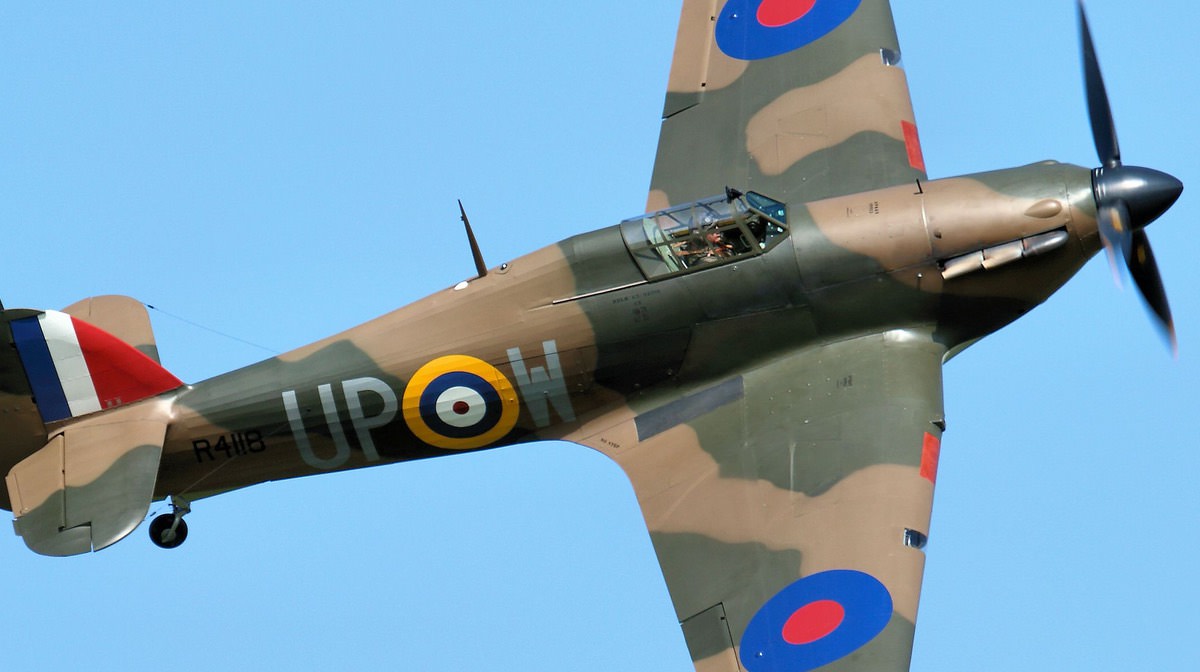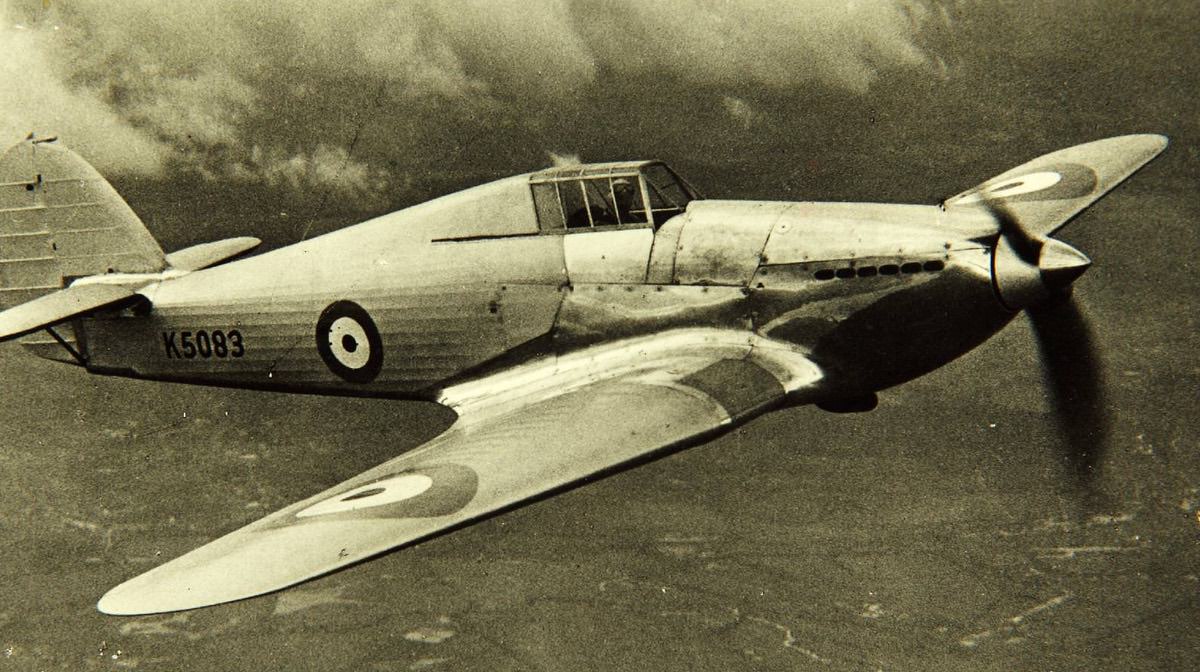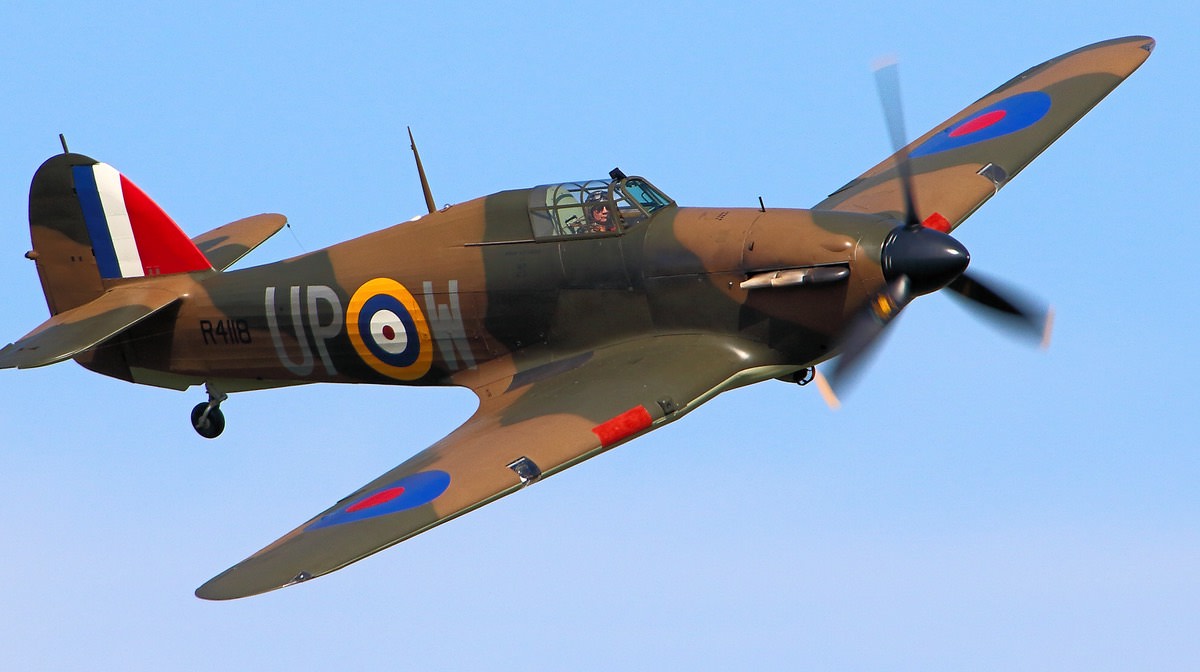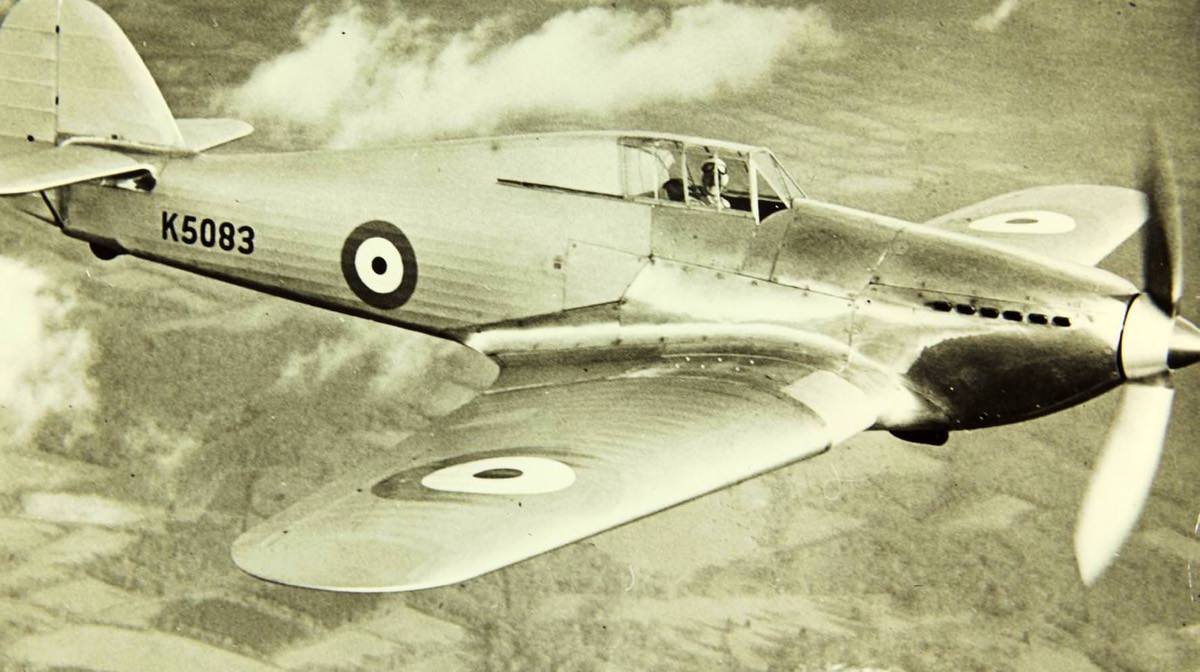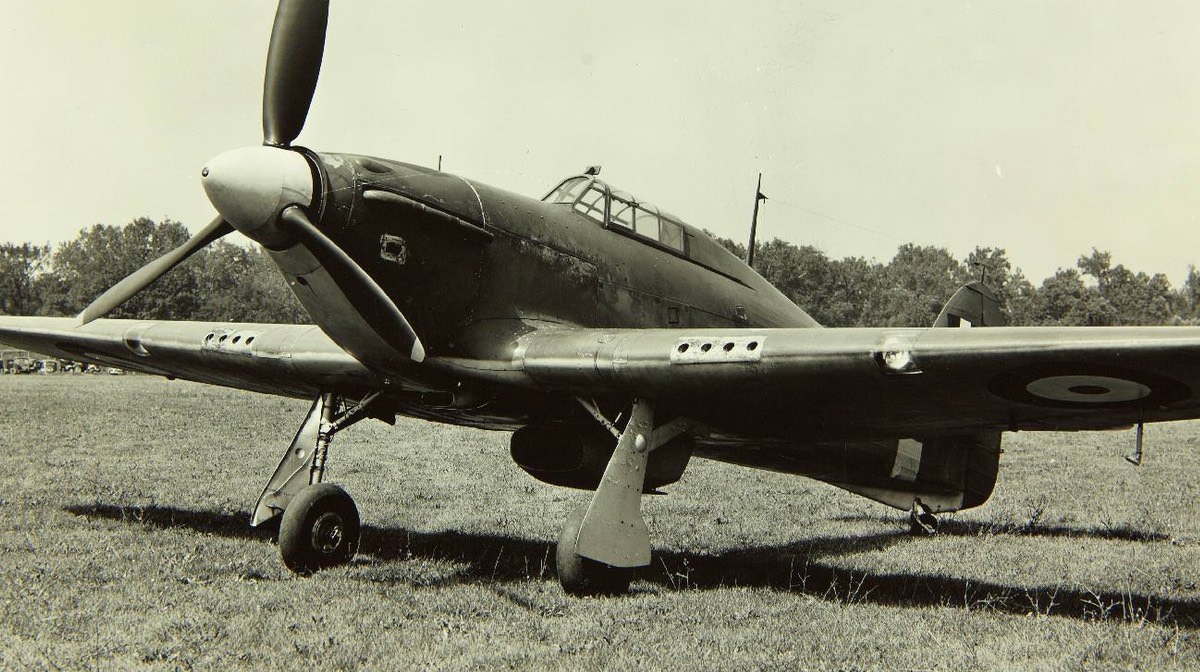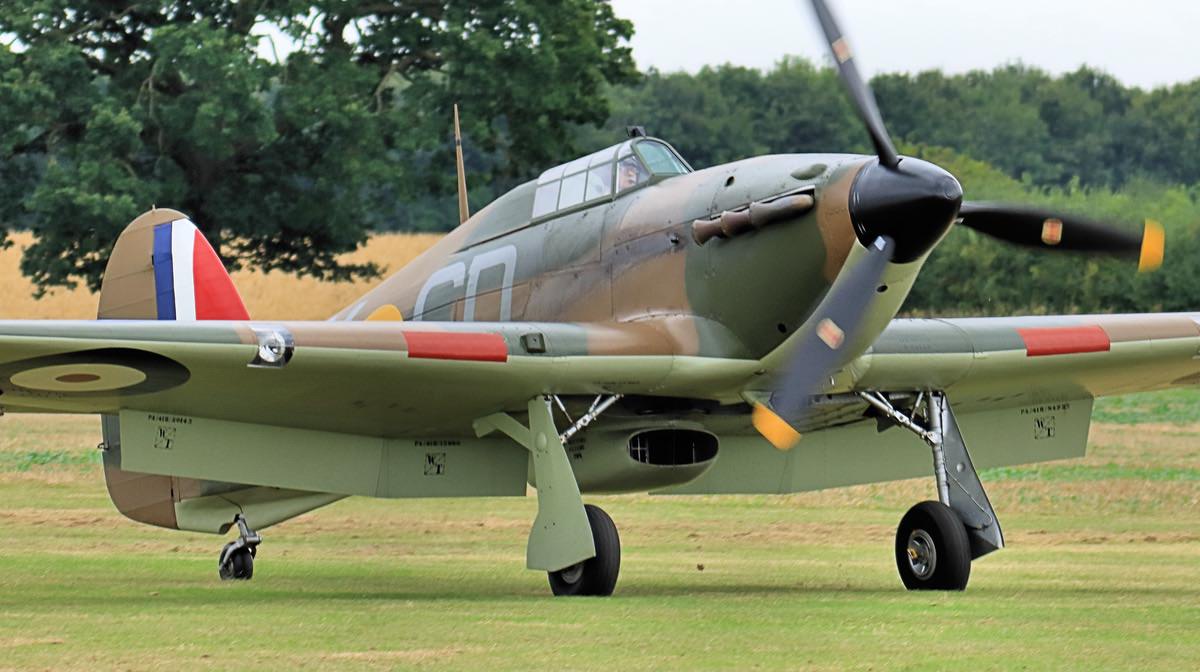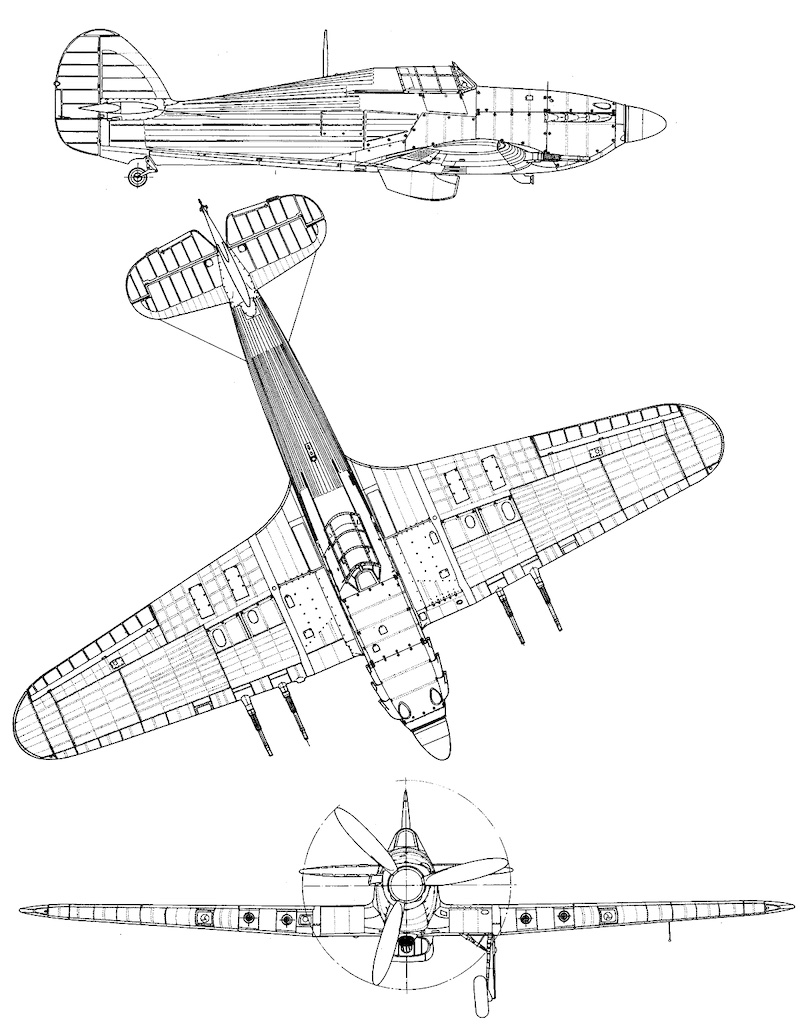Price: $19.95
- 4 magazines, 5 manuals, & photos
- PDF contains 522 pages
- Content is keyword searchable
- Print a personal copy
- Pay via PayPal or Credit Card
- International orders welcome!
- Download files upon payment
September 1986
- Hawker Hurricane, Most Versatile RAF Fighter of WWII
- Thunderceptor, Forerunner of Republic F-105 Thunderchief
October 1996
- Behind the Big Wing Controversy
- Lockheed’s F-104 Starfighter
- The Yak Fighter, Star of Soviet Union’s WWII Guard Brigades
May 1999
- Seaplanes: Gone But Not Forgotten
- The RAF Hurricane, Spitfire, and Mosquito
November 2001
- The Art of Supercharging from Single Stage to Turbos
- The Siege of Malta
Manuals & Photos
- Hawker Hurricane / Merlin II Manual, 1939
- Hawker Hurricane I, Merlin II or III Engine Pilot’s Notes, 1940
- Hawker Hurricane IIa, IIb, IIc, IId, IV & Merlin XX Engine Pilot’s Notes, 1944
- Hawker Hurricane Pilot’s Notes, 1940
- NACA Hawker Hurricane Flying Qualities, 1942
- Over 500 photos of the Hawker Hurricane
Hawker Hurricane
Specs. Mk.IIC
Variants
On Display
Cutaway
Videos
General Characteristics
- Crew: One
- Length: 32 ft 3 in (9.83 m)
- Wingspan: 40 ft 0 in (12.19 m)
- Height: 13 ft 1.5 in (4.001 m)
- Wing area: 257.5 sq ft (23.92 m2)
- Airfoil: root: Clark YH (19%); tip: Clark YH (12.2%)
- Empty weight: 5,745 lb (2,606 kg)
- Gross weight: 7,670 lb (3,479 kg)
- Max takeoff weight: 8,710 lb (3,951 kg)
- Powerplant: 1 × Rolls-Royce Merlin XX V-12 liquid-cooled piston engine, 1,185 hp (884 kW) at 21,000 ft (6,400 m)
- Propellers: 3-bladed
Performance
- Maximum speed: 340 mph (550 km/h, 300 kn) at 21,000 ft (6,400 m)
- Range: 600 mi (970 km, 520 nmi)
- Service ceiling: 36,000 ft (11,000 m)
- Rate of climb: 2,780 ft/min (14.1 m/s)
- Wing loading: 29.8 lb/sq ft (145 kg/m2)
- Power/mass: 0.15 hp/lb (0.25 kW/kg)
Armament
- Guns: 4 × 20 mm (0.79 in) Hispano Mk II cannon
- Bombs: 2 × 250 or 500 lb (110 or 230 kg) bombs
Australia
Airworthy
- Hurricane Mk.XII 5481 (registered C-FDNL) was imported from Canada in early 2014 and was returned to airworthy status, for a private owner, by Pay’s Air Service at Scone, NSW. It made its first flight in Australia on 2 October 2016.
Belgium
On display
- Hurricane Mk.IIc LF658 is on display at Musee Royal De l’Armee, Brussels, Belgium.
Czech Republic
Airworthy
- Hurricane Mk.IV KZ321 (previously registered G-HURY and CF-TPM) was the last surviving airworthy Mark IV. Built in the Kingston upon Thames factory in 1942, it served with No. 6 Squadron RAF in Grottaglie, Italy, and other squadrons in Greece and Yugoslavia. Abandoned in Palestine in 1947, the aircraft was returned to the UK in 1983. It was acquired by the Vintage Wings of Canada Collection, Gatineau, Quebec in 2006. This was sold in March 2018 and registered OO-HUR to Flying Aces Services & Training, making its first flight in Belgium on Sunday evening, 4 November 2018 at the Brasschaat Airfield. The plane has been sold to a private owner in the Czech Republic and restored with RAF livery JX-E commemorating Hurricane Mk.IIc of famous Czech WWII flying ace Karel Kuttelwascher. On June 14, 2021, the plane landed at To?ná airport near Prague where it expanded the collection of airworthy historical aircraft under the registration OO-HUR. The plane crashed during Cheb Aviation Days on August 14, 2022, killing pilot Petr Paces.
Canada
Airworthy
- Hurricane Mk.XII 5418 is on display but fully operational at the Reynolds-Alberta Museum in Wetaskiwin, Alberta.
On display
- Hurricane Mk.XII 5389 owned by the City of Calgary and on display at The Hangar Flight Museum. Restoration by the Calgary Mosquito Aircraft Society was completed in October 2019. The aircraft will soon have taxi-able status with a Packard Merlin 29 engine. The restoration work on the airframe is subcontracted out to Historic Aviation Services of Wetaskiwin, Alberta. During WWII this aircraft was assigned to No. 133 (Fighter) Squadron based at RCAF Station Boundary Bay, British Columbia for home defense.
- Hurricane Mk.XII 5461 is an airframe reconstructed around an original partial nose section, with many replica components (painted as “YO-J”, No. 401 Squadron RCAF markings) on display at The Commonwealth Air Training Plan Museum, Brandon, Manitoba.
- Hurricane Mk.XII 5584 is on display at the Canadian Aviation Museum, Ottawa, Ontario.
Stored or under restoration
- Hurricane Mk.XII RCAF 5447 [registered as C-GGAJ], manufactured in 1942 by Canadian Car and Foundry, now owned by Vintage Wings of Canada, Gatineau, Quebec. Currently under restoration to represent LE-A as flown by F/O Willie McKnight. 5447 was struck off charge from RCAF in 1946. In the inventory of Harry Whereatt Collection, Assiniboia, Saskatchewan, 1971. Assigned civil registration: C-GGAJ April 7, 2000. Restoration complete July 2000. Owned by Harry Whereatt, Assiniboia, Saskatchewan, 1988–2006. Vintage Wings acquired it from aircraft restorer Harry Whereatt of Assiniboia, Saskatchewan in 2006. Its most recent markings were stripped, to be replaced as Hurricane LE-A of 242 RAF – Canadian Squadron
France
Airworthy
- Hurricane Mk.IIa P3351 (registered F-AZXR, formerly ZK-TPK) was originally a Mk.I P3351. It was delivered to the RAF, and crashed near Prestwick on 21 July 1940. Rebuilt as Mk.IIa DR393, the aircraft was delivered to the Soviet Air Force in May 1941, serving for about two years before crashing near Murmansk, Russia in 1943. The hulk was eventually restored as a Mk.IIc in the UK from 1992 to 1995. It was transferred to New Zealand in 1995, and acquired by the New Zealand Fighter Pilots Museum, being rebuilt in its original identity as P3351 in W?naka, New Zealand. Its first flight after restoration occurred in Christchurch on 12 January 2000. On 10 February 2013, it was bought by Jan Roozen from the Alpine Fighter Collection via Platinum Fighter Sales and shipped to France; it arrived at Le Havre on 30 March and was taken to Aero Restoration Service at Dijon for re-assembly; it was registered as F-AZXR on 14 May 2013.
Finland
On display
- Hurricane I N2394, Finnish Air Force serial number HC-452 is on display Aviation Museum of Central Finland (Keski-Suomen Ilmailumuseo), Tikkakoski, Finland. It is the second oldest extant Hurricane in the world, and still bears the Finnish 1942 painted camouflage.
India
On display
- Hurricane displayed as Mk.IIa AP832, and later AB832, though these serials have never been allocated (the former is in a deliberate blank block between Hurricane Mk.IIb’s, and the latter is a deliberate blank block between Spitfire serials). The actual Mark of Hurricane is also in question (it is possibly Canadian built Mk.I P5202, but has the armored radiator of a Mk.IV, and the oil deflector ring of a Mk.II or later). The heritage of this aircraft and how it came to be in India is unknown, but it has been on display at the Indian Air Force Museum, Palam, New Delhisince 1975.
Stored or under restoration
- In 2021, the Indian Air Force Museum, Palam acquired a second Hurricane, a Mk.IIB, BN225, previously on outdoor display at the Police Academy at Moradabad. The aircraft was modified for outdoor display but its structure survives. The aircraft will require restoration to display standard.
Malta
On display
- Hurricane Mk.IIa Z3055 was ditched off the coast of Malta on 9 July 1941. It was recovered on 19 July 1995, and restored to static display condition. It is on display at the Malta Aviation Museum, Takali Airfield, Malta.
Russ
On display
- Hurricane Mk.IIc BM959 is a war memorial at Revda, 200 miles (320 km) from Murmansk in northern Russia.
- Hurricane Mk.IIb BN233 is at the Vadim Zadorozhny Museum of Technology, Krasnogorsky, near Moscow.
Serbia
On display
- Hurricane Mk.IV RP LD975 is on display at the Aeronautical Museum in Belgrade, Serbia.
South Africa
On display
- Hurricane Mk.IIc LD619 is held by the South African National Museum of Military History, Saxonwold, Gauteng, Johannesburg.
United Kingdom
Airworthy
- Hurricane Mk.I P2902 (registered G-ROBT), recovered wreck that crashed 31 May 1940 near Dunkirk.
- Hurricane Mk.I P3717 (registered G-HITT), recovered wreck from Russia, since traced to have Battle of Britain history.
- Hurricane Mk.I R4118 (one of the last flying Battle of Britain veterans; registered G-HUPW) is privately owned by Hurricane Heritage but since 2015 kept within the hangars of the Shuttleworth Collection (restored in 2004 by Hawker Restorations Ltd in the UK). Delivered new to No. 605 Squadron RAF at Drem on 17 August 1940. During the Battle of Britain, it flew 49 sorties from Croydon and shot down five enemy aircraft. Upon completion of its RAF service, it was sent to India as a training aircraft in December 1943, where it remained intact and in its packing crates until being struck off charge in 1947, after which it was sent to the Department of Aeronautical Engineering, Banaras Hindu University as an instructional airframe. Discovered in 1981 by Peter Vacher, returned to the UK in 2001 and restored to flying status, marking its first post-restoration flight (in nearly 60 years) on December 23, 2004. The aircraft is maintained by Duxford-based Aircraft Restoration Company.
- Hurricane Mk.XII P3700 (registered G-HURI), Canadian-built Hurricane Mk.XII, painted in 2015 to represent a Hurricane Mk.I RF-E No. 303 Squadron RAF and operated by the Historic Aircraft Collection, Duxford, Cambridgeshire.
- Hurricane Mk.IIc LF363 is operated by the Battle of Britain Memorial Flight, RAF Coningsby, Lincolnshire.
- Hurricane Mk.IIc PZ865, the last Hurricane built, operated by the Battle of Britain Memorial Flight at RAF Coningsby, Lincolnshire.
- Hurricane Mk.IIb BE505 (registered G-HHII), the last flying “Hurribomber”, Originally restored in 2005 by Hawker Restorations Ltd in the UK, now the world’s only two-seat Hurricane and is now maintained by Duxford-based Aircraft Restoration Company.
- Hurricane Mk.I V7497 (registered G-HRLI), recovered wreck that crashed 28 September 1940 operating with No. 501 Squadron RAF was restored by Hawker Restorations Limited of Sudbury, Suffolk. Returned to airworthy status on 30 August 2018 and now maintained by Duxford-based Aircraft Restoration Company.
On display
- Hurricane Mk.I L1592 is on display in 615 Squadron markings at the Science Museum, London. It is the oldest surviving Hurricane, having seen action in France in 1939 as well as the Battle of Britain.
- Hurricane Mk.I P2617 formerly operated by 607 and 615 Squadron on display in 607 Sqn markings at the RAF Museum Hendon, London.
- The wreck of Hurricane Mk.I P3175 which crashed on 31 August 1940 with 257 Squadron is on display at the RAF Museum Hendon, London.
- Hurricane Mk.IIb Z2315, a former Russian operated aircraft on display at the Imperial War Museum Duxford displayed in No. 111 Squadron RAF markings.
- Hurricane Mk.IIa Z2389, acquired from Russia via the late Jim Pearce in 1997, is in static display at the Brooklands Museum, Weybridge.
- Hurricane Mk.IV KX829 is on display at the Thinktank, Birmingham Science Museum, painted as P3395 as flown by Flight Lieutenant Arthur Clowes DFM of No. 1 Squadron RAF.
- Hurricane Mk.II LF738 is on display at the RAF Museum Cosford, Shropshire.
- Hurricane Mk.II LF751 painted as BN230 of No. 43 Squadron RAF and displayed at the Hurricane and Spitfire Memorial Museum at the former RAF Manston.
Stored or under restoration
- Hurricane Mk.IV KZ191 last operated by the Israeli Defence Force, privately owned in Berkshire.
- Hurricane Mk.IIb Z5207 (registered G-BYDL), a former Russian aircraft, is privately owned and stored in Gloucestershire.
- Hurricane Mk.XII (registered G-CBOE), a Canadian-built aircraft operated by the RCAF as 5487and crashed in 1942 is privately owned in Hampshire.
- Hurricane Mk.IIb BH238, the wreck of a former Russian aircraft, is privately owned and stored on the Isle of Wight.
- Hurricane Mk.I L1639 of No. 85 Squadron RAF from Battle of France is being restored to airworthy condition by Cambridge Bomber and Fighter Society at Little Gransden Airfield in Cambridgeshire.
United States
Airworthy
- Hurricane Mk.XII 5667 (registered N2549) operated by the Military Aviation Museum near Virginia Beach in Pungo, Virginia.
- Hurricane Mk.XII 5708 (CCF 96; registered N96RW) is owned by Lone Star Hurricane LLC and is part of the collection at the Dakota Territory Air Museum.
On Display / In Storage
- Hurricane Mk.IIc LF686 is on display at the Steven F. Udvar-Hazy Center of the National Air and Space Museum of the Smithsonian Institution, Washington, D.C.
- Hurricane Mk.II V6864 is on display at the Pima Air & Space Museum, adjacent to Davis-Monthan AFB in Tucson, Arizona. Composite of five Hurricanes in the markings of Robert Stanford Tuck while flying with No. 257 Squadron RAF in Summer, 1940.
- Hurricane Mk.XII 5390 is on display at the National Museum of the US Air Force at Wright-Patterson AFB in Dayton, Ohio; it is of Canadian manufacture and is painted to represent an aircraft of the No. 71 or “Eagle” Squadron RAF, composed of U.S. citizens who volunteered for British/Canadian service in the RAF beginning in September 1940 prior to US entry into World War II late the following year. It is marked as Hurricane Mk.IIa Z3174.
-
Hurricane Mk.I
- First production version, with fabric-covered wings, a wooden two-bladed, fixed-pitch propeller (first 435) or three blade two -pitch propeller, powered by the 1,030 hp (770 kW) Rolls-Royce Merlin Mk.II (first 364) or III engines and armed with eight .303 in (7.7 mm) Browning machine guns. Produced between 1937 and 1939.
-
Hurricane Mk.I (revised)
- A revised Hurricane Mk.I series built with a de Havilland or Rotol constant speed propeller (from February 1940), metal-covered wings, armour and other improvements. A total of 4,200 Mk.Is were built; 1,924 by Hawker, 1,850 by Gloster Aircraft Company and 426 by Canadian Car and Foundry between December 1937 and October 1941. Apart from 30 retained in Canada the Canadian Car and Foundry Hurricanes were shipped to England to be fitted with engines.
-
Hurricane Mk.IIA Series 1
- Hurricane Mk.I powered by the improved Merlin XX engine with two-speed supercharger. This new engine used a coolant mix of 30% glycol and 70% water. Pure glycol is flammable, so not only was the new mix safer, but the engine also ran approximately 21 °C (38 °F) cooler, which gave longer engine life and greater reliability. The new engine was longer than the earlier Merlin and so the Hurricane gained a 4.5 in “plug” in front of the cockpit, which made the aircraft slightly more stable due to the slight forward shift in centre of gravity. First flew on 11 June 1940 and went into squadron service in September 1940. Hawker built 418 and Gloster Aircraft Company 33. The series 1 may refer to the first production batch which did not have all the proposed changes incorporated, becoming series 2 when the changes were made. 33 Mk. IIA built by Gloster, 418 by Hawker.
-
Hurricane Mk.IIB
- Carrying four additional wing-mounted .303 in (7.7 mm) Browning machine guns; for a total of 12 guns, 230 were factory fitted with racks allowing them to carry two 250 lb (110 kg) or two 500 lb (230 kg) bombs. This lowered the top speed of the Hurricane to 301 mph (484 km/h), but by this point mixed sweeps of Hurricanes carrying bombs, protected by a screen of fighter Hurricanes were not uncommon. The same racks allowed the Hurricane to carry two 45 imp gal (200 L) drop tanks instead of the bombs, nearly doubling the Hurricane’s fuel load.
- A total of 3,178 IIBs built in Britain to November 1942, 2,011 by Hawker, 867 by Gloster Aircraft Company and 300 by the Austin Aero Company, plus another 515 by Canadian Car and Foundrybuilt November 1941 to March 1943. Many of the Canadian built aircraft being fitted with C (cannon) wings before delivery to the RAF.
-
Hurricane Mk.IIB Trop.
- For use in North Africa the Hawker Hurricane Mk.IIB (and other variants) were tropicalised. They were fitted with Vokes and Rolls-Royce engine dust filters and the pilots were issued with a desert survival kit, including a bottle of water behind the cockpit.
-
Hurricane Mk.IIC
- Replaced the machine-gun armament with four 20 mm (0.79 in) Hispano Mk.II cannons, two per wing. The new wings later included a hardpoint for a 500 or 250 lb (230 or 110 kg) bomb and, later again, fuel tanks. By then performance was inferior to the latest German fighters, and the Hurricane changed to the ground-attack role, sometimes referred to as the Hurribomber. The Mk. IIC also served as a night fighter and intruder with about three quarters converted to fighter bombers. There were 4,751 IICs built by Hawker between February 1941 and July 1944.
-
Hurricane Mk.IID
- Armed with two 40 mm (1.57 in) anti-tank autocannon in a gondola-style pod, one under each wing and a single Browning machine gun in each wing loaded with tracers for aiming purposes. The first aircraft flew on 18 September 1941 and deliveries started in 1942. Had additional armour for the pilot, radiator and engine, and were armed with a Rolls-Royce gun with 12 rounds, later changed to the 40 mm (1.57 in) Vickers S gun with 15 rounds. The outer wing attachments were strengthened so that 4G could be pulled at a weight of 8,540 lb (3,870 kg). The weight of guns and armour protection marginally impaired the aircraft’s performance. These Hurricanes were nicknamed “Flying Can Openers”, perhaps a play on the logo of No. 6 Squadron, which flew the Hurricane starting in 1942. A total of 296 built by Hawker from January 1942 to February 1943.
-
Hurricane Mk.IIE
- Not an official Mark number. First used informally by the RAF for 100 mark IIB factory fitted with bomb racks built September to December 1941, which were then redesignated mark IIBB. Also used by the Ministry of Aircraft Production March to October 1942 for further production, all up 270 considered built, comprising 230 IIBB and 40 IICB by the later RAF designation (230 IIB and 40 IIC). A signal to the Middle East dated 31 October 1942 states the IIE was not an official mark. The Mk.IIE was not an early Mk.IV.
-
Hurricane Mk.T.IIC
- Two-seat training version of the Mk. IIC. Only two aircraft were built, for the Imperial Iranian Air Force.
-
Hurricane Mk.III
- Version of the Hurricane Mk.II powered by a US Packard-built Merlin engine, intending to enable supplies of the British-built engines for other designs. Probably two Canadian built aircraft test flown in Britain with a Merlin 28 starting in May/June 1942 before becoming mark IIB with Merlin XX. By the time production was to have started, British Merlin production had increased to the point where the idea was abandoned
-
Hurricane Mk.IV
- The last major change to the Hurricane was the introduction of the “universal wing”, a single design able to mount two 250 or 500 lb (110 or 230 kg) bombs,or two 40 mm (1.57 in) Vickers S guns, or two 40 mm (1.57 in) Rolls-Royce B.H. type guns, two SBC (small bomb containers) or SCI (smoke curtain installation),or two 45 or 90 gallon drop tanks or eight “60 pounder” RP-3 rockets. Two .303 in (7.7 mm) Brownings were fitted to aid aiming of the heavier armament. Despite persistent reports, Mk.IVs were actually fitted with the same Merlin XX as the Mk.II. All Merlin 27s were modified to Merlin 25 and used in Mosquitoes, there were only 16 production Merlin 24s by the time over 300 Mk.IV had been delivered. The individual aircraft cards held by the RAF museum reports the final Mk.IV had a Merlin XX. The radiator was deeper and armoured. Additional armour was also fitted around the engine. 524 built by Hawker between December 1942 and March 1944.
-
Hurricane Mk.V
- The final variant to be produced. Only one was purpose built and two Mk.IV converted, though the variant never reached full-scale production. This was planned to be powered by a Merlin 27 but also tested with a Merlin 32 boosted engine to give 1,700 hp (1,300 kW) at low level and was intended as a dedicated ground-attack aircraft to use in Burma. All three prototypes had four-bladed propellers. The Mk. V replaced the twin 7.7mm machine guns on the Mk. IV with two 20mm cannons, only completed on the third prototype. Speed was 326 mph (525 km/h) at 500 ft (150 m)
-
Hurricane Mk.X
- Not an official Mark number. The Mk.X designation is used by some RAF documents for Canadian Car and Foundry built Mk.I but many references define it as Mk.II airframes fitted with a Merlin 28 Canadian Car and Foundry report building a total of 915 Mk.II airframes for Holland (one), the RAF (514) and the RCAF (400), between November 1941 and May 1943. About two thirds of the Canadian Car and Foundry built Mk.II airframes shipped to Britain did so without an engine, the remainder being fitted with Merlin 28s, but the engine was nearly always removed upon arrival and a Merlin XX fitted instead. These aircraft were considered a Mk.II by the RAF. Apart from some test flights in Canada and England no Hurricane flew powered by a Merlin 28. Canada only imported 285 Merlin 28 for Hurricanes, all of which were shipped to Britain either as a separate engine or attached to a Hurricane.
-
Hurricane Mk.XI
- Not an official Mark. number. Designation used by many references for 150 aircraft from the RCAF Mk.XII order sent to Britain, these aircraft had many items and their Merlin 29 removed before being shipped without an engine or fitted with a Merlin 28. Fitted with Merlin XX on arrival in Britain and called a Mk.II by the RAF.
-
Hurricane Mk.XII
- Canadian-built variant. On 19 August 1941, the Canadian government placed an order with Canadian Car and Foundry for 400 Hurricanes, with 100 meant for the Netherlands and 300 for China, the Netherlands order was amended to 72, the Chinese decided to buy American, which resulted in 328 being offered to the USSR, to be shipped across the Pacific. Amended to all 400 for the RCAF. Originally designated the Mk.IIB (Can), designation changed to Mk.XII in April 1943. Single-seat fighter and fighter-bomber, powered by a 1,300 hp (970 kW) Packard Merlin 29, armed with twelve 0.303 in (7.7 mm) machine guns, production starting in June 1942, 250 served with the RCAF and 150 were sent to Britain in 1943 either without an engine or fitted with a Merlin 28 which was replaced by a Merlin XX on arrival and they became Mk.IIs
-
Hurricane Mk.XIIA
- Canadian-built variant. The survivors of a batch of 30 RAF order Mk.I airframes retained in Canada in late 1941 that were fitted with Merlin III and propellers from Fairey Battles, became Mk. XIIA when fitted with Merlin 29. Armed with eight 0.303 in (7.7 mm) machine guns
-
Holland standard Hurricane
- Canadian built variant. RAF serial airframe AM270 was completed around early March 1942 to Dutch standards, including US built Merlin, instruments and gun sight, as the prototype of an order for the Netherlands East Indies (KM/KNIL). Given the Dutch serial HC3-287, its subsequent fate is unclear beyond being used by Canadian Car and Foundry for test flying. AM270 was also used by the RAF for a Consolidated San Diego built Catalina, creating a further level of confusion.
-
Sea Hurricane Mk.IA
- The Sea Hurricane Mk.IA was a Hurricane Mk.I modified by General Aircraft Limited. They were modified to be carried by CAM ships (catapult-armed merchantman), whose ships’ crews were Merchant Marine and whose Hurricanes were crewed and serviced by RAF personnel, or Fighter Catapult Ships, which were Naval Auxiliary Vessels crewed by naval personnel and aircraft operated by the Fleet Air Arm. These ships were equipped with a catapult for launching an aircraft, but without facilities to recover them. Consequently, if the aircraft were not in range of a land base, pilots had to bail out or to ditch.
- Both of these options had their problems—there was always a chance of striking part of the fuselage when bailing out, and a number of pilots had been killed in this way. Ditching the Hurricane in the sea called for skill as the radiator housing acted as a water brake, pitching the nose of the fighter downwards when it hit the water, while also acting as a very efficient scoop, helping to flood the Hurricane so that a quick exit was necessary before the aircraft sank. Then the pilot had to be picked up by a ship. More than 80 modifications were needed to convert a Hurricane into a Sea Hurricane, including new radios to conform with those used by the Fleet Air Arm and new instrumentation to read in knots rather than miles per hour. They were informally known as “Hurricats”.
- The majority of the aircraft modified had suffered wear-and-tear serving with front line squadrons, so much so that at least one example used during trials broke up under the stress of a catapult launching. CAM Sea Hurricanes were launched operationally on eight occasions and the Hurricanes shot down six enemy aircraft for the loss of one Hurricane pilot killed. The first Sea Hurricane Mk.IA kill was an Fw 200C Condor, shot down on 2 August 1941. The Hurricanes performance was somewhat hindered as a result of the extra equipment carried that was necessary for carrier operations, although this doesn’t seem to have effected its reputation among FAA pilots, with whom it was extremely popular.
-
Sea Hurricane Mk.IB
- Hurricane Mk.I version equipped with catapult spools plus an arrester hook. From July 1941 they operated from HMS Furious and from October 1941, they were used on merchant aircraft carrier (MAC) ships, which were large cargo vessels with a flight deck fitted, enabling aircraft to be launched and recovered. The first Sea Hurricane Mk.IB kill occurred on 31 July 1941 when Sea Hurricanes of 880 squadron FAA operating from HMS Furious shot down a Do 18 flying-boat.
- Apart from the conversions in Britain, 50 Sea Hurricane Mk.I were built in Canada and delivered in late 1941 and early 1942. Initially fitted with a Merlin III, they became Mk.XIIA when later fitted with a Merlin 29.
-
Sea Hurricane Mk.IC
- A Sea Hurricane Mk.I version reported equipped with the four-cannon wing. Despite persistent reports of hundreds converted from early 1942 only eight have been traced, all from a batch of 10 Sea Hurricanes that were sent to General Aircraft Limited in February 1943 from The Merchant Ship Fighter Unit, 7 being returned in May as Ic.
- The Sea Hurricane I used during Operation Pedestal had their Merlin III engines modified to accept 16 psi (110 kPa) boost, and could generate more than 1,400 hp (1,000 kW) at low altitude. Lt. R. J. Cork was credited with five kills while flying a Sea Hurricane I during Operation Pedestal.
- The RAF reports as of end June 1944 a total of 378 conversions to Sea Hurricane I, less any conversions back to standard Hurricanes, photographic evidence suggests it was 378 transfers to the Royal Navy, most of which were converted to Sea versions.
-
Sea Hurricane Mk.IIC
- 60 built by Hawker between November 1942 and May 1943, version equipped with naval radio gear; other standard Mk.IICs were converted and used on fleet carriers. The Merlin XX engine on the Sea Hurricane generated 1,460 hp (1,090 kW) at 6,250 ft (1,900 m) and 1,435 hp (1,070 kW) at 11,000 ft (3,400 m). Top speed was 322 mph (518 km/h) at 13,500 ft (4,100 m) and 342 mph (550 km/h) at 22,000 ft (6,700 m). Another 47 mark IIB converted to Sea mark II, with 45 of them given C wings as part of the conversion.
-
Sea Hurricane Mk.XIIA
- 50 Canadian built Sea Hurricane I delivered in late 1941 and early 1942. Initially fitted with Merlin III as Mk.I, the survivors became Mk.XII when fitted with Merlin 29.
-
Hillson F.40 (a.k.a. F.H.40)
- A full-scale version of the Hills & Son Bi-mono slip-wing biplane/monoplane, using a Hawker Hurricane Mk.I returned from Canada as RCAF ser no 321 (RAF serial L1884). Taxi and flight trials carried out at RAF Sealand during May 1943, and at the Aeroplane and Armament Experimental Establishment, Boscombe Down from September 1943. The upper wing was not released in flight before the programme was terminated due to poor performance.
-
Hurricane Photo Reconnaissance
- The Service Depot at Heliopolis in Egypt converted several Hurricanes Is for photo reconnaissance. The first three were converted in January 1941. Two carried a pair of F24 cameras with 8-inch focal length lenses. The third carried one vertical and two oblique F24s with 14-inch focal length lenses mounted in the rear fuselage, close to the trailing edge of the wing, and a fairing was built up over the lenses aft of the radiator housing. A further five Hurricanes were modified in March 1941, and two were converted in a similar manner in Malta during April 1941. During October 1941 a batch of six Hurricane Mk.IIs were converted to PR Mk.II status and a final batch, thought to be of 12 aircraft, was converted in late 1941. The PR Mk.II was said to be capable of slightly over 350 mph (560 km/h) and was able to reach 38,000 ft (12,000 m).
-
Hurricane Tac R
- For duties closer to the front lines some Hurricanes were converted to Tactical Reconnaissance (Tac R) aircraft. An additional radio was fitted for liaison with ground forces who were better placed to direct the Hurricane. Some Hurricane Tac R aircraft also had a vertical camera fitted in the rear fuselage, so to compensate for the extra weight either one or two Brownings or two cannon would be omitted. Externally these aircraft were only distinguishable by the missing armament.



